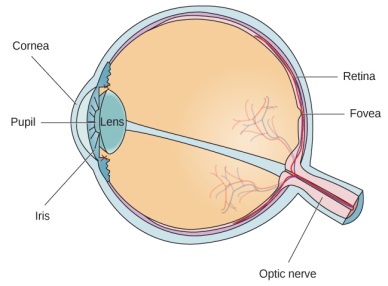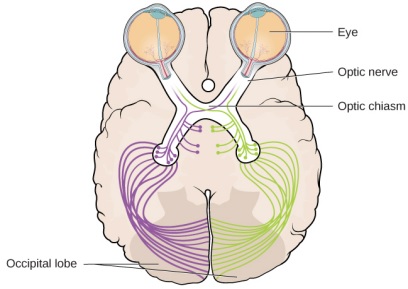HOW OUR EYES FUNCTION?
Parts and Process
The visual system constructs a mental representation of the world around us. This contributes to our ability to successfully navigate through physical space and interact with individuals and objects in our environments. The eye (Figure 1) is the major sensory organ involved in vision.

Figure 1: Anatomy of Eye
Light waves are transmitted across the cornea and enter the eye through the pupil. The cornea is the transparent covering over the eye. It serves as a barrier between the inner eye and the outside world, and it is involved in focusing light waves that enter the eye. The pupil is the small opening in the eye through which light passes, and the size of the pupil can change as a function of light levels as well as emotional arousal. When light levels are low, the pupil will become dilated, or expanded, to allow more light to enter the eye. When light levels are high, the pupil will constrict, or become smaller, to reduce the amount of light that enters the eye. The pupil’s size is controlled by muscles that are connected to the iris, which is the coloured portion of the eye.
Light waves are transmitted across the cornea and enter the eye through the pupil. The cornea is the transparent covering over the eye. It serves as a barrier between the inner eye and the outside world, and it is involved in focusing light waves that enter the eye. The pupil is the small opening in the eye through which light passes, and the size of the pupil can change as a function of light levels as well as emotional arousal. When light levels are low, the pupil will become dilated, or expanded, to allow more light to enter the eye. When light levels are high, the pupil will constrict, or become smaller, to reduce the amount of light that enters the eye. The pupil’s size is controlled by muscles that are connected to the iris, which is the coloured portion of the eye.
While cones are concentrated in the fovea, where images tend to be focused, rods, another type of photoreceptor, are located throughout the remainder of the retina. Rods are specialized photoreceptors that work well in low light conditions, and while they lack the spatial resolution and colour function of the cones, they are involved in our vision in dimly lit environments as well as in our perception of movement on the periphery of our visual field.
Rods and cones are connected (via several inter-neurons) to retinal ganglion cells. Axons from the retinal ganglion cells converge and exit through the back of the eye to form the optic nerve. The optic nerve carries visual information from the retina to the brain. The optic nerve from each eye merges just below the brain at a point called the optic chiasm. Once inside the brain, visual information is sent via a number of structures to the occipital lobe at the back of the brain for processing (Figure 2).






